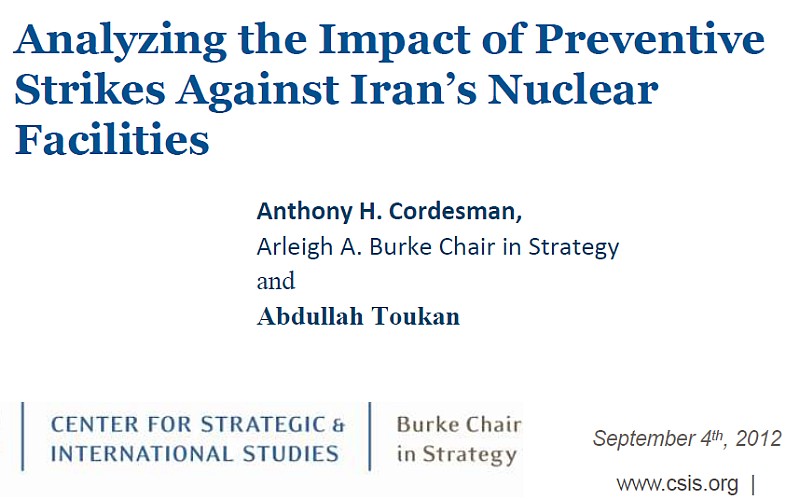War With Iran
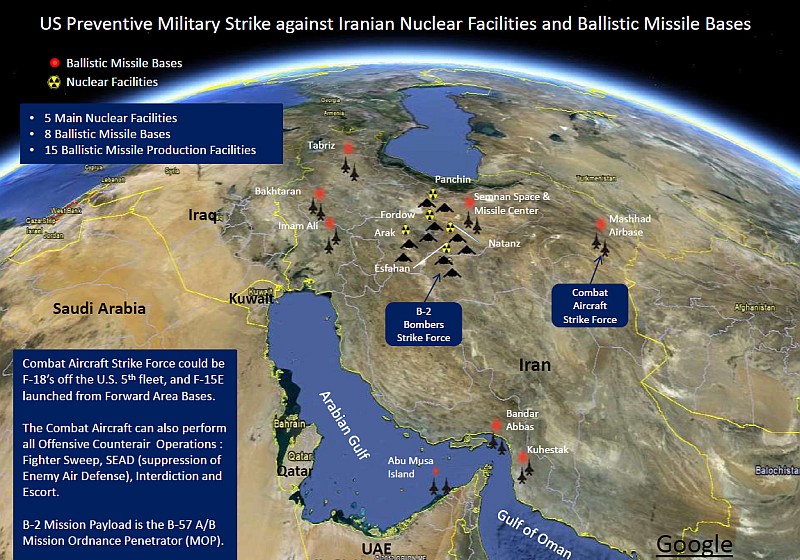
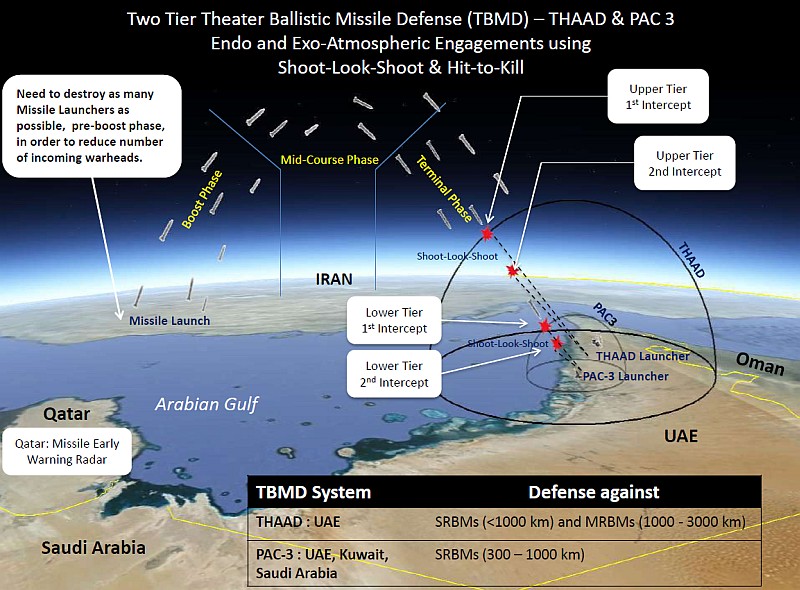
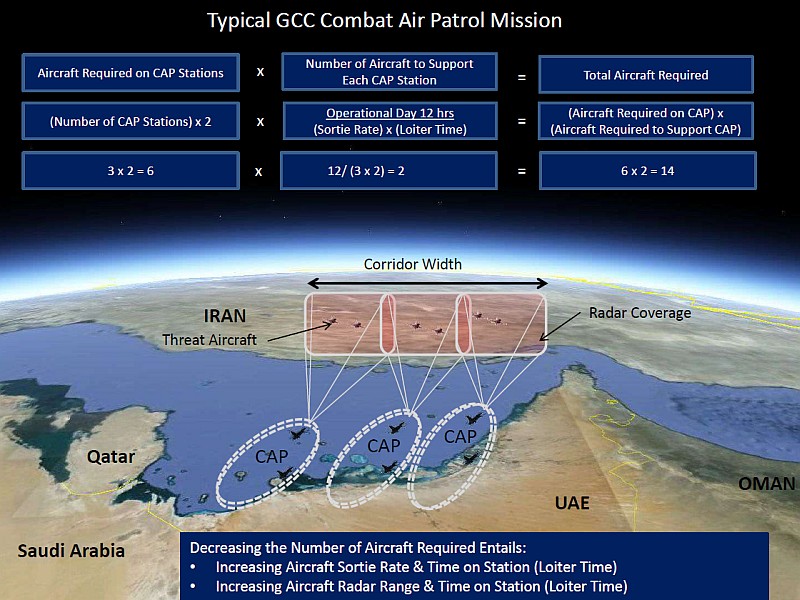
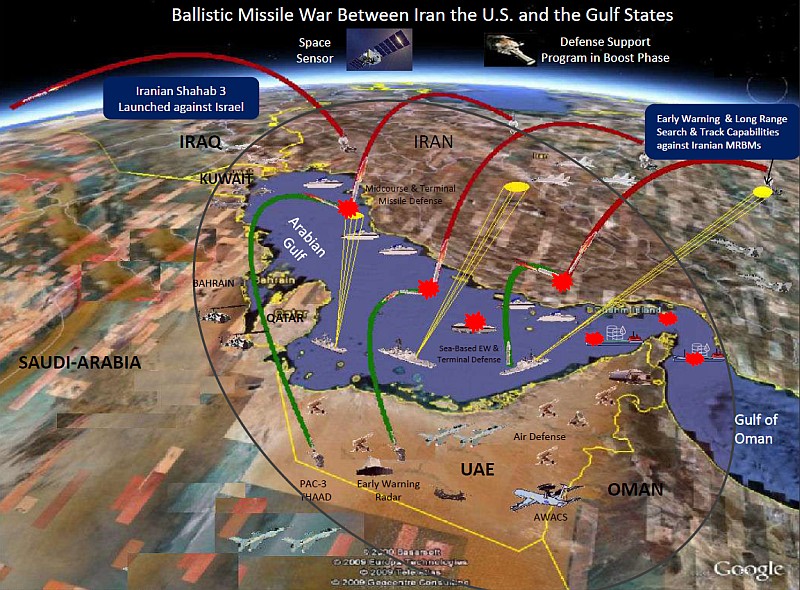
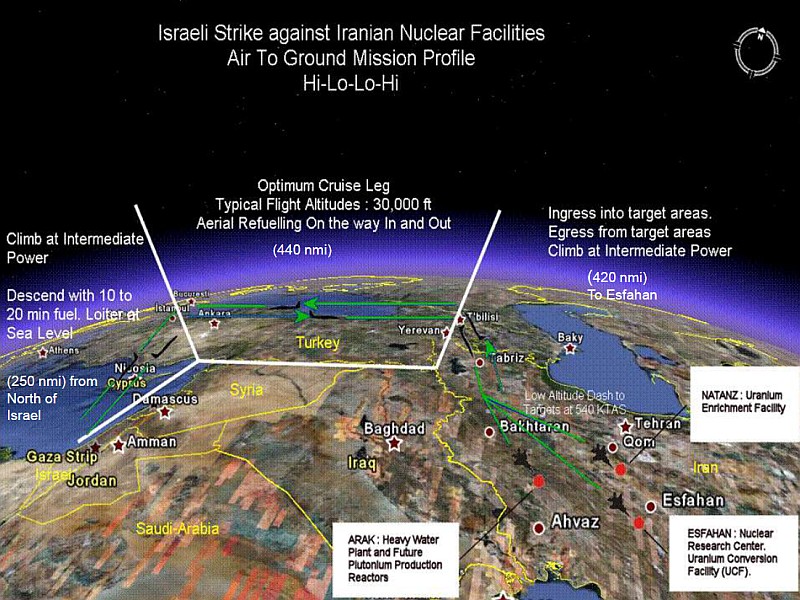
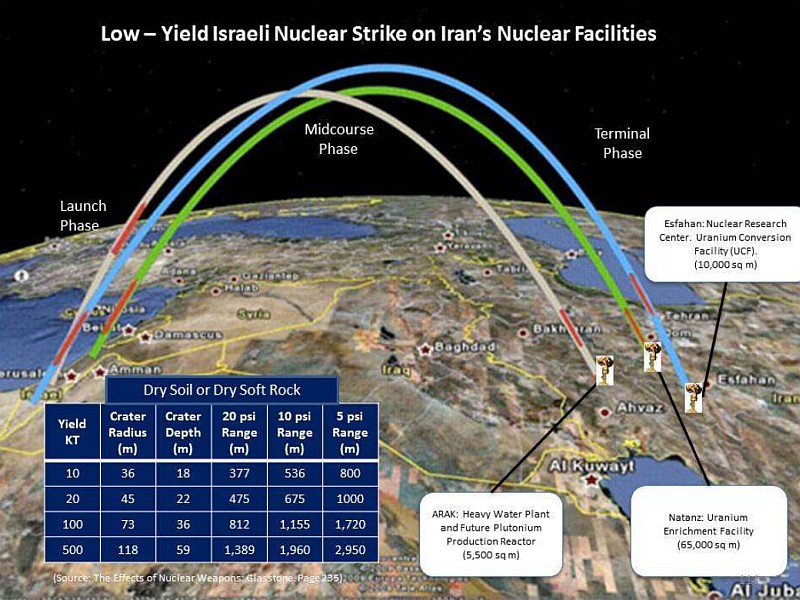
Israel Versus Iran
By
Mark Perry
Foreign Policy, September 27, 2012
Edited by Andy Ross
U.S. Central Command and Pentagon war planners have concluded that there are at least three possible Israeli attack options against Iran's nuclear facilities. Israel may need the United States to join militarily, but the U.S. military currently has no interest in a preventive strike.
Option 1
A massed Israeli Air Force bombing campaign targets key Iranian nuclear
sites. Such an assault would be coupled with strikes from submarine-launched
cruise missiles and Israeli-based medium-range Jericho II and long-range
Jericho III missiles, according to a highly placed U.S. military officer.
The attack may include a coordinated cyber and electronic warfare attack.
But the Joint Chiefs of Staff and Centcom planners conclude that such an
aerial campaign could not be sustained: "They'll have one shot, one time.
That's one time out and one time back. And that's it."
Israel has
about 25 sophisticated F15I and 100 smaller F16I warplanes, but only the
F15Is can carry the bunker-busting GBU-28 guided missile, and even then only
one each.
The Israeli Air Force would likely have to carefully pick
and choose its targets, settling most probably on four: the heavy-water
production plant at Arak, the uranium-enrichment centers at Fordow and
Natanz, and the uranium-conversion facility at Isfahan, while leaving out
the military site at Parchin and the nuclear reactor at Bushehr, which
houses Russian technical experts.
The Israeli F16Is would knock down
Iran's air defense network, or perhaps drop other, less effective,
bunker-busting munitions. Some of these F16Is, but not all of them, would be
able to refuel from Israeli KC-707 tankers.
Even with that, and even
with the best of luck, senior U.S. military officers say that Israel would
only set back Iran's nuclear capability by one to two years at best.
The U.S. arsenal includes the Massive Ordnance Penetrator, the GBU-57, which
can punch through 200 feet of hardened concrete before detonating its
5,300-pound warhead. The United States is rumored to have only about 20 in
its inventory. Only a B-2 bomber can carry it.
Option 2
Israelis mount a high-risk but high-payoff commando raid that would land an
elite Sayeret Matkal (special forces) unit outside of Iran's enrichment
facility at Fordow, near Qom. The soldiers would seize Iran's enriched
uranium for transport to Israel.
The operation's success would depend
on speed, secrecy, simplicity, and the credibility of Israeli intelligence.
According to the Pentagon war planner, Israel's access to intelligence on
Iranian military and policy planning is unprecedented, as is their
willingness to share it with U.S. intelligence officials.
The Israeli
unit would be transported on a small flight of C-130 aircraft protected by a
swarm of F16I fighters. The C-130s would land in the desert near Fordow. The
Israeli commandos would then defeat the heavily armed security personnel at
the complex, penetrate its barriers and interdict any enemy units nearby,
and seize the complex's uranium for transport back to Israel. Prior to its
departure, the commando unit would destroy the complex.
Benjamin
Netanyahu and Defense Minister Ehud Barak are former Sayeret Matkal
officers, and recently Israeli Defense Forces head Benny Gantz said the IDF
had formed an elite special operations "Deep Corps" to strike far inside
hostile territory.
The difficulty with the Entebbe-style option is
that Israel would be forced to mount a robust combat search and rescue
(CSAR) capability to support it. That would mean deploying other C-130s
carrying helicopters that could pick up endangered commandos or retrieve
downed aircraft crews. Such CSAR units would have to be deployed to nearby
countries, or even land in the desert. This CSAR component complicates the
operation.
Option 3
The Israelis could just take out the Iranian leadership. A decapitation
strike iwould not end Iran's nuclear program. But it would almost certainly
trigger an Iranian response targeting U.S. military assets in the region, as
it would leave the Iranian Revolutionary Guard forces in charge of the
country. It would be the one sure way for Israel to get the United States
involved.
A Pentagon planner: "If the Iranians harass us, we can deal
with it, but if they go after one of our capital ships, then all bets are
off." A U.S. response would not involve a full-scale, costly land war
against the Tehran regime, but rather a long-term air interdiction campaign
to erode Iranian military capabilities, including its nuclear program.
But a decapitation campaign would deepen the rift between the Obama
administration and the Netanyahu government. Retired Army officer Lt.
General Robert Gard: "Our commitment to Israel has been as solid as with any
ally we've ever had, and a lot of officers are proud of that. But we've done
it so that they can defend themselves. Not so they can start World War III."
In Centcom war game Internal Look, the United States was "pulled into" a
regional conflict in the wake of an Israeli attack. The results "were
particularly troubling" to Centcom commander General James Mattis. Internal
Look found that Iranian retaliation against U.S. military assets could
result in "hundreds of U.S. deaths," probably as the result of an Iranian
missile attack on a U.S. naval vessel. The game also showed that the less
warning the United States has of an Israeli attack, the greater the number
of casualties taken.
Eight Ways to Deal With Iran
By Stephen J. Hadley
Foreign Policy, September 28, 2012
Option 1: Seek an interim "stop the clock" agreement
The United States and the international community (USIC) seek to negotiate
with the Iranian regime an interim agreement that prevents further Iranian
progress toward a nuclear weapon capability. Neither side ia asked to
concede its current position on the core of the nuclear issue and the
existing sanctions regime remain in place. Each side has an incentive to
continue negotiations to reach a more permanent agreement.
Iran
agrees under intrusive IAEA inspection and verification procedures to:
-
Cease any uranium enrichment beyond 3.5%
- Cease further expansion of
operations at its underground Fordow enrichment plant
- Commit to take no
further steps toward developing a nuclear weapon capability
The USIC
agrees to:
- Provide fuel for the Iranian medical research reactor and
medical isotopes
- Impose no additional sanctions during the period of
the interim agreement
According to press reports, the Obama
administration has already proposed something along these lines that the
Iranian regime has so far flatly rejected.
Potential benefits of
Option 1:
- Freezes the most obvious avenues for enhancing Iranian
nuclear capability
- Builds confidence and trust
- Buys time for
sanctions and other measures to have effect
Potential costs of Option
1:
- Leaves centrifuges in operation at both Natanz and Fordow
-
Provides time for Iran to strengthen the defenses around its nuclear
infrastructure
- Depends on Iranian authorities allowing intrusive
inspection and verification measures
- May not satisfy Israel
Option 2: Seek an interim "medium for medium" or "more for more" agreement
The USIC seeks to negotiate an interim agreement that requires greater
concessions from both sides but still stops short of a final agreement.
The USIC provides fuel for the Iranian medical research reactor, medical
isotopes, and civilian aircraft spare parts, and commit not to impose any
additional sanctions. Existing sanctions are alleviated as Iran comes into
compliance with its obligations under the interim agreement.
In
addition to agreeing under intrusive IAEA inspection and verification
procedures to cease enrichment beyond 3.5% and to cease further expansion of
operations at Fordow, Iran is required to ship most of its 3.5% enriched
stockpile out of the country. Enrichment at the 3.5% level can continue.
Potential benefits of Option 2:
- Freezes the most obvious
avenues for enhancing Iran's nuclear weapon capability
- Reduces Iran's
stockpile of 3.5% enriched uranium to low levels and increases inspection
- Builds trust and confidence
Potential costs of Option 2:
-
Leaves centrifuges in operation at Natanz and Fordow
- Gives Iran time to
strengthen the defenses around its nuclear infrastructure
- May take too
long to negotiate
If the Iranian negotiators stall on moving further,
an interim agreement could hinder USIC efforts to increase the pressure.
The USIC would have to commit in advance to imposing new sanctions if the
final agreement deadline is missed.
Option 3: Seek a final agreement that resolves the nuclear issue
USIC negotiators seek an agreed final resolution of the nuclear issue in a
single negotiating step. The problem is that a final agreement will take
time to negotiate, and without an interim agreement in place, the Iranian
regime is free to move forward with its nuclear program.
A final
agreement invites USIC to declare victory, unwind the sanctions, reduce the
pressure, and resume normal relations with the Iranian regime. If the
Iranian regime then begins eating around the edges of the agreement, it may
be difficult to reestablish the existing sanctions and pressure the regime
in time. Any final agreement needs to include a prior agreement on a
response in the event of any substantial violation. A list of substantial
violations could be included in a UN Security Council resolution.
As
the Iranian regime implements its undertakings, the USIC agrees to:
-
Support Iran in developing a truly peaceful civilian nuclear power program
- Undertake steps to resuscitate, revitalize, and reform the Iranian economy
- Encourage businesses, universities, and charitable foundations to
establish training centers in Iran
- Establish robust exchange programs
within Iranian civil society
- Commit to no new nuclear-related economic
sanctions and gradually reduce existing sanctions
- Reestablish
diplomatic relations over time
- Include Iran as a full partner in an
international nuclear club located elsewhere
Consistent with the
phased implementation process, Iran agrees to:
- Forego nuclear
reprocessing and disband all its existing facilities
- Forego enriching
uranium beyond 3.5% and give over to the IAEA all stocks of such enriched
uranium
- Shut down and dismantle its uranium enrichment facility at
Fordow
- Accept and implement the IAEA Additional Protocol and full IAEA
inspection and monitoring
- Resolve all its issues with the IAEA
Potential benefits of Option 3:
- Resolves the nuclear issue on terms
acceptable to both sides and provide an enforcement mechanism
-
Establishes a framework of relations that could advance progress in dealing
with the other grievances
- Opens opportunities for greater interaction
between the USIC and the Iranian people
Potential costs of Option 3:
- Draws down the leverage and incentives that the USIC have for changing
the behavior of the Iranian regime
- Allows Iran to perfect its
enrichment capability
- Enhances the legitimacy of the Iranian regime
Option 4: Embrace the de facto status quo
This option aims to establish a de facto status quo acceptable to the USIC
based on a set of redlines. The purpose is to freeze the Iranian nuclear
weapon program at its current level without rolling back the program. The
approach gives the USIC enough time to respond to an Iranian effort to dash
for the bomb. The USIC threatens action against the Iranian nuclear program
if these redlines are crossed.
The redlines:
- Resuming
nuclear weaponization research or other weaponization activities
-
Enriching over 3.5%
- Failing to cooperate with the IAEA or throwing out
its inspectors
- Opening any new enrichment or reprocessing facility
-
Discovery of a covert nuclear facility
- Failure by Iran to freeze
activity at Fordow
Any redlines declared by Iran are liable to be
fairly extreme. Perhaps the regime would accept a more limited set of
redlines, such as:
- No new UN Security Council resolutions on the
Iranian nuclear program
- No new nuclear-related USIC sanctions
-
Cessation of any clandestine actions within Iran
- Cessation of further
IAEA efforts to resolve questions about past Iranian activities
Operationalizing this approach may require secret contacts between
representatives of the UN Security Council and elements of the Iranian
regime.
To pressure Iran to accept this approach, the USIC could
discuss additional sanctions they might impose, including:
-
Targeting front companies that supply Iran with components for the nuclear
program
- Targeting banks that work with the National Iranian Tanker
Company
- Targeting certain petroleum resource development joint ventures
outside Iran
- Blacklisting Iran's entire energy sector and labeling Iran
a zone of proliferation concern
Potential benefits of Option 4:
- Freezes the Iranian nuclear program and leaves time to react if Iran
makes a dash for the bomb
- Avoids both the political costs of formal
negotiations and the downsides of military action
- Puts the Iranian
regime's claim that it does not seek a nuclear weapon to the test
Potential costs of Option 4:
- Without a freeze at Fordow it does not
stop Iran from entering the zone of immunity.
- Hard to get UN Security
Council authorization for military force in the event of violation
-
Leaves Iran free to take action just short of the redlines
Option 5: Long-term isolation and pressure
The USIC undertakes a long-term strategy of isolating and pressuring the
Iranian regime. The goal is to get the Iranian regime either to abandon
unilaterally its effort to obtain nuclear weapons capability or to engage in
serious negotiations.
This option is attractive if the USIC decides
that the Iranian regime is unable or unwilling to enter into a negotiated
settlement or if negotiations break down. It could be an alternative or a
follow-up to military action.
Under this approach, the existing
vehicles of pressure and sanctions are maintained and strengthened.
Additional measures could include:
- Targeting front companies that
supply Iran with components for the nuclear program
- Targeting banks
that work with the National Iranian Tanker Company
- Targeting certain
petroleum resource development joint ventures outside Iran
- Blacklisting
Iran's entire energy sector and labeling Iran a zone of proliferation
concern
- Joint military exercises with Gulf and regional allies
-
Expanded U.S. military assistance and cooperation with regional states
-
Greater emphasis on interdicting arms and funding flowing to and from Iran
- Creative ways to engage broader elements within Iranian society
These measures may cause debate and division within the Iranian regime.
This effort could be a long one, comparable to the Cold War effort. In
the interim, the USIC would have to manage aggressive and dangerous efforts
by the Iranian regime to "break out of the box" of increasing pressure and
isolation. Such actions could include:
- Increasing financial and
material support to terrorist organizations
- Inciting violence through
proxy groups in Iraq, Afghanistan, Syria, and Lebanon
- Destabilizing
international oil markets
- Increasing the threat to Israel
Potential benefits of Option 5:
- Avoids capitulation to the Iranian
pursuit of a nuclear weapon capability
- Offers the possibility of a
positive resolution of the nuclear issue
- Encourages transformation of
the Iranian regime to one more cooperative with the USIC
Potential
costs of Option 5:
- Requires an enormous USIC commitment
- Risks
disruptive and dangerous Iranian behavior threatening USIC interests
-
May turn the Iranian people against the USIC
- May prompt Iranian leaders
to dash for the bomb
Option 6: Launch a limited, and preferably clandestine military strike
A military strike comes under consideration in the event that:
-
Negotiations break down
- The Iranian regime violates an agreement
-
The Iranian regime takes other steps toward a nuclear weapon capability
-
The USIC embrace limited strikes as part of a longer-term strategy
The objective of military action could be:
- To persuade the Iranian
regime to return to negotiations
- To induce the Iranian regime to return
to compliance
- To dissuade or prevent the regime from moving further
toward a nuclear weapon capability
- To enforce redlines
- To change
the behavior and policies of the Iranian regime over the longer term
Any military action:
- Raises the stakes in the confrontation
-
Risks unforeseen and uncontrollable consequences
- Risks letting the
Iranian regime continue toward a nuclear weapon capability
- Causes
division within the USIC over Iran
- Erodes support for curbing Iran's
nuclear weapon efforts after the strike
Prior to any use of military
force it should be established that:
- The negotiating track has
clearly failed
- Iran has violated an interim agreement
- Iran has
violated a final agreement and a UN Security Council resolution
- Iran
has violated a declared USIC redline
To achieve its objectives, any
military action should:
- Be clearly focused on the nuclear issue
- Limit any collateral damage
- Not be clearly attributable to the United
States or Israel
A limited and clandestine military action best meets
these criteria. It could be focused on one or more of the following:
- Any new facilities or operations undertaken by the Iranian regime that
violate any agreement or USIC redlines
- The deeply buried enrichment
facility at Fordow but not the more vulnerable enrichment facility at Natanz
- The enrichment facilities at Fordow and Natanz and the heavy water reactor
under construction at Arak
- A very small number of facilities that
provide critical support to these enrichment and reprocessing sites
Any resort to military force is best undertaken by the United States, for
these reasons:
- Its leaders have said an Iranian nuclear weapon
capability is unacceptable
- It has led the international effort to deal
with this problem
- It has capability to conduct an effective military
operation
- It is a hard target for any Iranian retaliation
- Its
attack may generate less hostility within Iran than an Israeli strike
-
Israeli military action would result in severe criticism and isolation of
Israel
- Holding the sanctions coalition together later would be easier
The United States could use the prospect of a military strike to enhance
the effectiveness of its diplomacy. A limited military strike will need to
be well prepared diplomatically and operationally and must be followed by
increased pressure on Iran.
Potential benefits of Option 6:
-
Adds credibility to USIC efforts to prevent Iran from getting a nuclear
weapon
- May sow division and discord within the Iranian regime and the
Iranian public
- May buy more time on the Iranian nuclear clock
Potential costs of Option 6:
- Pushes the Iranian regime to declare
explicitly that it is pursuing nuclear weapons
- Prompts the regime to do
all it can to push up oil prices
- Causes controversy within the USIC
- May rally Iranian public opinion around the regime and against the USIC
Option 7: Launch a major, overt military strike
A major military action can only be conducted by the United States. It hits:
- All facilities associated with a potential Iranian nuclear weapon
capability
- Iranian air defense facilities
- Iranian military
aircraft, military airfields, and missile complexes
The USIC is
unlikely to view failure of negotiations as justifying a major military
strike. Advance preparations would be required to:
- Safeguard the
region's civilian infrastructure and military installations from Iranian
attacks
- Insulate the world economy from a major potential disruption in
the oil and gas markets
Potential benefits of Option 7:
- Does
maximum damage to Iran's nuclear program
- Causes the Iranian regime to
question its own survival
- Degrades Iran's conventional retaliatory
capability
Potential costs of Option 7:
- Prompts the Iranian
regime to declare its intention to seek nuclear weapons
- Strengthens
public support in Iran for the regime and anger against the USIC
- Puts
pressure on USIC support for a robust Iran policy
- Sows controversy and
division within the United States
- Escalates into a war
Option 8: Acquiesce in a nuclear-armed Iran
If efforts to resolve the confrontation over the nuclear issue fail, and the
USIC either decide to forego the military option or find that it does not
achieve their desired objectives, they could elect simply to accept an
Iranian regime with a clear path to a nuclear weapon, and even with a
nuclear weapon itself. This course of action would reflect a judgment that
an Iran with nuclear weapons could be deterred or contained.
AR This is all rather worrying.
